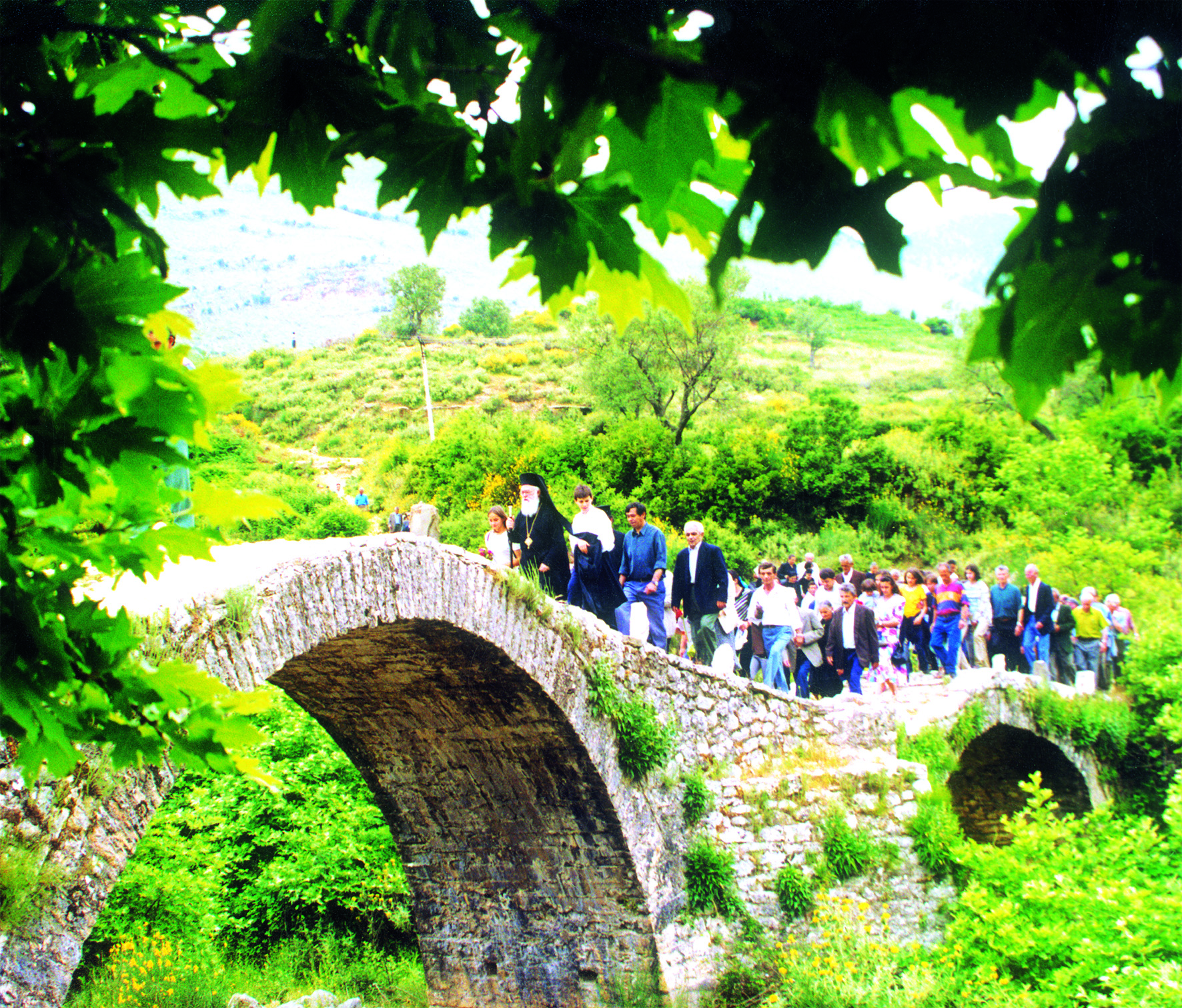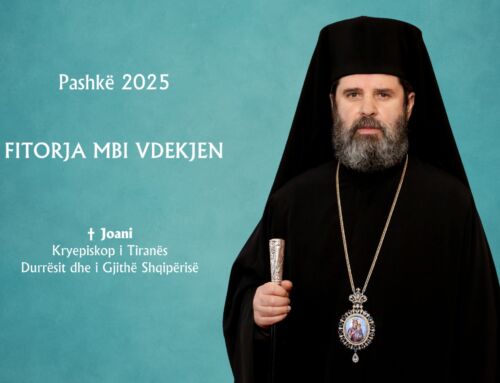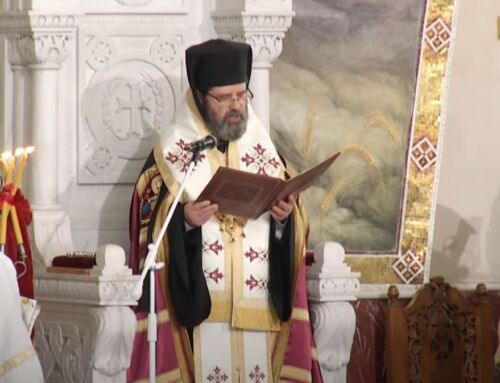“Upon my arrival in Albania, what I felt was great pain and a deep sense of suffering developed inside me about what had happened; about those events that we had followed only from abroad as spectators.”
In an interview that reveals many truths, the head of the Orthodox Autocephalous Church of Albania, His Beatitude Anastasios, claims, for the News Agency of Athens and Macedonia, about his hard work, his aims and great efforts to restore the Autocephalous Orthodox Church of Albania. His work dates back to June 1992, when His Beatitude was elected as Archbishop of Tirana, Durrës and All Albania, and still continues to be as such till the present day. ALA-MA met him in Larissa, where he was honored by the mayor of the town for his colossal spiritual and social work and the bridges of love and solidarity that he has set up.
Archbishop Anastasios Jannullatos, who has studied in Greece and Germany, as he himself says, has always had the vision of working in our country and in Africa. In January 1991, while working as professor of the University of Athens and Acting Metropolitan of the Holy Metropolis of Irinupolus in East Africa, he received a phone call from the Ecumenical Patriarchate announcing that he was chosen to be the Patriarchal Exarch in Albania who would closely look at what had remained from Orthodoxy in this country, in which faith had been denied for 23 years under the most cruel atheist persecution in the world.
“I had never thought of anything like that. But I obeyed the request of the ecumenical throne and accepted such an unknown task to me until then,” he declares for the ALA-MA, underlining that it took six months to be issued a visa to him from the Albanian authorities. A year later, in the position of the head of the Church, he finds himself in very difficult circumstances.
The Post-Communist Albania
Archbishop Anastasios presents the situation which he was chosen back then to manage and also the dark reality in Albania in 1992. “We have dealt with persecution of religion at other periods of time as well, but what had happened in Albania was something unique: the Church was totally destroyed. We have not encountered similar phenomena in the history of mankind. No other country has ever been proclaimed atheistic by constitution. Enver Hoxha wanted to be so original in this aspect as well. Most of the churches had collapsed or were turned into stalls, wheat warehouses, blacksmiths, cinemas, etc.
All the clergymen were forced to abandon their duty. However the worst thing was not that the churches were destroyed, but the fact that the persecutors had tried to eradicate the faith from the hearts of the people. Education from primary school to university was systematically turned into atheistic education. Ruthless persecution had led the country to a spiritual decline. As Dostoyevsky writes, “When there is no God, everything is allowed.”
Hope Was Re-established
With the great confidence that hope would be reborn again, His Beatitude arrived in Albania at the age of 62 with no knowledge of Albanian language. “In this country they had crucified and buried Christ for 23 years, but finally Christ had been risen”, he emphasizes and confesses that the words of this paschal greeting were the first ones he learnt in Albanian.
“When we arrived at the ruined cathedral church site of the Evangelization of Theotokos, which during the communist regime was repurposed and turned into a gym, I asked people how they say ‘CHRIST IS RISEN’ in Albanian and I asked each of them to light a candle. When all candles were lit, I called out loud, “Christ is risen!” And with lots of heartburn and tears, the few people in attendance answered, “Truly He is risen!” Hope was risen. There was already a vision for the future. All of our work during these years has been carried out in the midst of clouds, rains and various difficulties. But “Christ is risen!” and this slogan set the pace of our entire work,” he emphasizes for the News Agency.
A Mosaic of Balkan Reality
Reality in Albania also defined the uniqueness of the Church, which the Shepherd had to administer in order to build bridges of love, solidarity and perspective. Beyond the fact that “the Church of Albania was completely disintegrated, it constituted a mosaic of Balkan reality,” says Archbishop Anastasios and describes the peculiarities of the environment within which he tried to convey the message of the Gospel.
“One particularity of this Church is that there was no uniformity in ethnicity. And this is not easily understood. The church members are Albanians, Greeks, Slavs, Vlachs (from the latter some are related to Greece and others to Romania, while another group is assimilated to the society of the country). From the very first moment we tried to get all united. In a symbolic way I remarked, “All the trees of the forest are free to develop under the Sun of Justice. We also accepted those who wanted to follow the Old Calendar. We are a mosaic of Balkan reality.”
The Role in Society
With the basic principle that “every human person is an icon of God, that is, a respectable person,” Archbishop Anastasios respects all religious beliefs and has developed co-operation and understanding between all religious communities.
As he explains, the Autocephalous Orthodox Church of Albania does not constitute the majority of the population in the country, as in other countries of the Balkan Peninsula, but it is not even a limited minority, as in other centers of old Patriarchates, and he states,
“We make up about 20-22% of the entire country’s population. We have an important role in society. At the same time, there are those who question this role. From the first moment we tried to cultivate mutual understanding and respect. Every human person is respectful to us. All men are creatures of God. Having a different religious belief constitutes simply a personal choice and it is an issue of personal freedom. We respect and love everybody and cooperate with them all.”
A Life Dialogue with Other Religious Communities
Archbishop Anastasios emphasizes in particular that “the word ‘tolerance’ has something arrogant in it”, and with steadfast determination he states, “We strive for harmonious relationships of understanding and coexistence. The other can be different but this does not mean that he is an opponent or an enemy. We maintain good relations with the Sunit Muslim Community, the Bektashi Community, the Catholics and the Protestants in Albania. We are in a “life dialogue”. It is clear that we stick to our ideas and faith of course. We are what we are, but we have no conflicting relations.”
An Open Window for the Society and Culture
The Resurrection of Christ Cathedral Church complex prevails in the center of Tirana marking the rebirth of the Orthodox Church and simultaneously constitutes a focal point for the spread of culture; thus it is “an open window for the society,” as Archbishop Anastasios declares. In the premises below the Cathedral Church, a Cultural Center is built, which keeps its doors open for various activities. “We are an open community that does not worry or fear. We radiate confidence, love and hope. We look at people with respect and without fear or concern. “
The laborious resurrection from the ruins of the Autocephalous Orthodox Church of Albania is also reflected in the murals painted on the eastern wall of the Nativity of Christ Chapel located outside the Cathedral. The artist, Mr. Kristo Papanikolau, a fellow of the Archbishop for 18 years, besides iconography, dares to sketch icons and scenes from the road to the resurrection of the Church in the villages and cities of Albania during these 25 years.
Professor of the Tirana Academy of Arts, Mr. Vladimir Myrtezai, in a critical article of his own, refers precisely to the beauty of art work that speaks silently within the chapel (Paraklisis), where the very talented artist utilizes the balances within the environment and creates light and shadow through lines, thus composing a unique work of art. The Nativity of Christ Chapel is a work of cultural achievement and heritage for the Albanian people, which is donated by Archbishop Anastasios.
Hardships during the Ministry
Within the difficult situation of deep decline of Orthodoxy in Albania, Archbishop Anastasios, by putting into practice the theological thinking and the ierapostolical experience of the previous centuries, acted decisively by taking the following steps in three directions: a) the use of mother tongue in worshipping services, catechism and preaching; B) the ordination of the local clergy; C) the providing of financial funds. He speaks more analytically about the above points highlighting that, “Worship is performed in Albanian. In Greek villages, the Greek language is used of course, among the Slavs, the services are performed in Slavic etc.” In addition, during the 25 years of his ministry, monthly newspapers, magazines and books (160) have been published in Albanian, which have further enriched the Orthodox literature.
For the ordination of the local clergy, priests from Greece and America originally came to Albania to help Archbishop Anastasios during the first period of his work. Seminars were later organized, and eventually the Theological Academy was set up. “I did not accept any clergy candidate who had not finished the high school and who was not willing to further continue his studies,” Archbishop highlights, adding that 160 clerics have been educated and ordained up to now (of whom 10 have slept through God). Also several Bishops of Albanian origin have been ordained who are highly educated in theology.
The economic independence of the Autocephalous Orthodox Church of Albania has been the hardest work. “We needed to secure stable income from local resources. At first we started to deposit in banks and then buy real estate. Over time, with the help of God, through various donations and bank loans, we made possible the construction of a hydropower plant which revenues would be used to cope with the basic needs of the Church and to ensure the continuity of the church educational and social work. And there are not only the clerics with their families, but also 800 employees who offer their skills in 30 schools of all levels, in various health centers and social domain.
A Work of Love for the Good of the Society
Archbishop Anastasios spoke in general about big trials and hard attempts to find the necessary financial resources in order to enable the charitable and social work in Albania. “The economic situation was difficult. The church was very poor. All the church property was confiscated. However, during this period, 150 new churches were built, over 160 existing churches were reconstructed and over 60 monuments of culture were restored. In many cases we had to build roads, water supply, dormitories, clinics and schools of all levels. All these works are an expression of love towards God and man. Glory to God, many benevolent people responded to our begging for economic aid such as people from Greece and other countries of Europe, from America and Australia. Some cases are particularly impressing.”
Archbishop Anastasios concludes by saying, “The Autocephalous Orthodox Church of Albania is not only reinvigorated with all its ecclesiastical structures, but it also contributes immensely to the country’s revival, as well as to the spiritual and social development of Albania.
06/18/2017
09:00 Athens and Macedonia News Agency
Μ. Xhora
Ioannina




